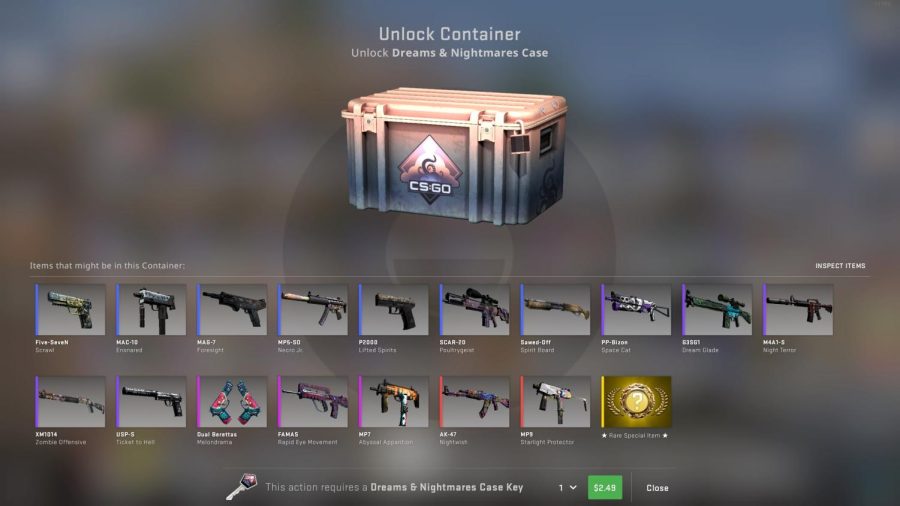Here’s What Young Adults Have to Say on Microtransactions in Gaming
Microtransactions are a purchase made within a virtual game that gives the user cosmetic items in return for real life currency to which people have spent thousands of dollars on.
Preview of the contents within the “Dreams & Nightmares” case from “CS:GO” ranging from the most common to the rarest of cosmetics, increasing in value with rarity.
The first purchasable microtransaction from a AAA publisher was in the 2006 game “The Elder Scrolls IV: Oblivion” by Bethesda. This microtransaction offered virtual armor for the user’s horse at the cost of $2.50. This addition to Bethesda’s game would cause other AAA game developers and publishers to dive into the world of microtransactions.


Game publisher and developer Valve is seemingly the kingpin of microtransactions in gaming pulling in $54 million on a monthly basis within just one of their games. Valve’s top game is “Counter-Strike: Global Offensive” when it comes to making money.
“CS:GO” generates high revenue through rebranded gambling. The game offers cases that contain virtual weapon skins however these cases are locked until the player spends $2.50 on a key to open their case. Certain skins in these cases depending on how rare they are and the condition they’re in are worth in the hundreds to thousands of dollars although there is however an abundance of common skins that are not in high demand causing them to only be worth a few cents which is less than the key to open a case costs.
“I pulled two reds with a combined worth of probably about $130,” said Central Kitsap High School senior Noah Walsh.
The rarities of the cosmetics from “CS:GO” cases are as follows: gray, light blue, blue, purple, pink, red, and gold (knives and gloves). The worth of the cosmetics is determined by the rarity of it and the demand of the cosmetic; if a case is rare then it is likely most of the skins in the case will be profitable.
“[I would consider CS:GO cases gambling, it is definitely potentially predatory for younger audiences] and the fact that there isn’t a whole lot of regulation behind this it’s kind of scuffed [like dangerous], it can lead to children being introduced to gambling at a very young age,” said Noah.
All virtual games have an age rating that ranges from E for everyone and M for mature – however, there isn’t a way to possibly prevent a child from making a new account with a birthdate that says they are eighteen years of age. This is a primary cause for children being exposed to microtransactions at a younger age than intended.
“[I started spending my own money on video games in 2014] I was eleven, I actually calculated about a year back [I’ve spent $20,000 since then],” said Dylan Brown.
Dylan Brown has many cosmetic items in “CS:GO” from opening cases and claims to have even made a profit, making a profit on gambling including “CS:GO” is statistically difficult with reds and golds only having a drop percentage chance of 0.64% and 0.26% chance.
“I believe my decisions have gotten smaller and smarter as I’ve gotten older, and I’ve even made profit,” said Dylan.
Even though Dylan has made a profit from opening the virtual cases, he doesn’t buy into cases anymore due to the fact that it is more likely for the player to lose money per the norm.
“[I haven’t bought CS:GO cases] in about two years, I have found there’s no real purpose you lose money most of the time,” said Dylan.
Cases/loot boxes that require a fee to open are not the only type of microtransaction though it is the most profitable. Other games such as “Valorant” offer skins at a set price sold by the official games store rather than a community market or a third party site. Buying a pack of cosmetic skins in “Valorant” can potentially be more expensive than getting lucky and pulling a rare cosmetic from a relatively cheap “CS:GO” case however the odds are stacked against the user in that being cheaper.
“I play a bunch of games but the one that occupies most of my time right now is Valorant,” said Central Kitsap High School senior Tina Nguyen. “I recently looked how much I’ve spent on that game and it’s a free to play game, the way that game makes its money is through customizables or like gun skins or really cool knives you can get, they don’t really contribute anything to the game at all except for just really cool cosmetics and my total spent I took a screenshot actually and it says $546.66 and my first ever purchase was January 5, 2023.”
Microtransactions in virtual games are here to stay due to the immense amount of revenue they generate for the games that harbor these transactions, the larger gaming publishers will continue to determine what the standard cost for these items are and how much will be in their games.



